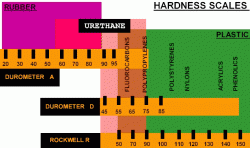A cobbler friend, and many others I suppose, use a press to complete bond of soles with commercial rubber-cement like adhesive.
His works up-acting, ram carrying the shoe forms. Above, foam rubber blocks distribute pressure evenly. Pic not identical, but similar operation.There is no heat involved, and blocks are mounted to 11 lamination plywood. His blocks are severely worn, and asked what could be done about replacement. Company built the machine offer replacements at a staggering price. The rectangular blocks are 110mm x 270mm x 100mm, and as mentioned resilient foam, with a structure about like Styrofoam cells.
I don't have or know anyone with a durometer. Has anyone an alternate method, to pursue material performing at least something like original?
No, haven't found a supplier in the immediate vicinity, who should be able to squeeze it and say "...that's about xxxx Shore...", figuring I''ll end up on the 'net and order. It seems logical to make a couple sets. Hope is for bulk material and bandsaw into size.
https://en.wikipedia.org/wiki/Shore_durometer Durometers, measure in one of a set range: Types A, B, C, D, DO, E, O, OO, OOO
Can't figure how to term specialized topic into a 25 character tag...rubber measurement technique, comparator, rubber hardness scale.


 LinkBack URL
LinkBack URL About LinkBacks
About LinkBacks


 Reply With Quote
Reply With Quote





Bookmarks